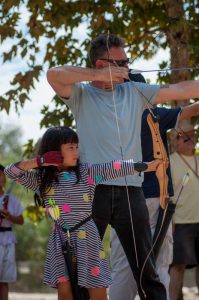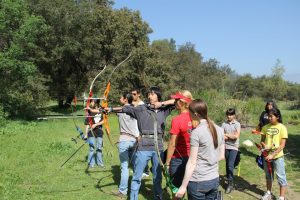
The popularity of archery has soared over the last two years, particularly among girls and women. At my archery club, our women’s memberships doubled, and our children’s program tripled in size, within a period of about six months, and the numbers continue to increase. In the spring of 2012, Louis Vuitton decorated their stores with archery-themed window displays, and by the time the Summer Olympics rolled around, archery was the most-watched event on cable TV. This sudden explosion in interest was largely fueled by the release of two films, The Hunger Games and Brave, both of which featured teenage girls wielding bows.
According to a survey conducted by the Archery Trade Association, approximately 8% of US residents participated in archery in 2012. That’s one out of every 12.5 people, a total of about 18.9 million. Breaking it down a bit more, about 55% participated only in target archery, 35% took part in both target archery and bowhunting, and just 10% were involved in bowhunting only. This survey only includes archers over the age of 18, but youth archery programs across the country are reporting expanded programs, full classes, waiting lists and back-ordered equipment. Similar growth is reported around the world. Among all sports shown on cable TV during the 2012 Olympics, archery was the most-watched.
As an archery instructor (and co-director of the youth program at my local range), I am often asked about archery safety, usually by parents whose children have expressed interest in the sport.
So how safe is archery? Absurdly safe.

Photo courtesy of Pasadena Roving Archers.
Safe enough that most ranges have never had a serious accident or injury. According to the National Safety Council’s statistics, archery is more than three times safer than golf. For every 2,000 people that participate in the sport, fewer than one will be injured. For golf, it’s about 1 in 625. About 94% of archery injuries are caused by hunters cutting themselves with their razor-sharp hunting arrowheads, which are not permitted at most recreational archery ranges. Other than those, the most common injury is slapping the wrist with the bowstring, which does hurt, but can be prevented through use of proper equipment and instruction. Injuries to innocent bystanders are statistically zero at archery ranges; the very rare cases of someone being hit by an arrow almost always occur when someone is practicing in an unsafe area such as a backyard without supervision, instruction or adequate fencing.
In most urban and suburban areas, archery is prohibited by law in backyards, parks, and other open areas, unless specifically designated as an archery range or hunting area. Archery ranges, whether public or private, generally carry insurance in case of an accident. As an indicator of how safe the sport is, the insurance premiums for an archery range are roughly equivalent to insurance for badminton, handball, or golf. This is one reason not to practice archery in your backyard; if a stray arrow should happen to go onto a neighboring property, your homeowner insurance may not cover any liability that results, especially if backyard archery is illegal. Additionally, depending on the local laws, you could be charged with discharging a firearm or some similar violation, which could have much more serious consequences. It’s best to practice at an actual range where qualified instructors can supervise and provide expert guidance.

Photo courtesy of Pasadena Roving Archers.
For children who are interested in archery, there are several options; both USA Archery and the National Field Archery Association have children’s programs. USA Archery, the organization that trains the US Olympic team, has the Junior Olympic Archery Development Program (JOAD), while NFAA runs the After School Archery Program (ASAP), and several states are participating in the National Archery in the Schools Program (NASP). Additionally, many archery shops, ranges, and summer camps offer archery instruction. Many offer free introductory lessons, and most provide or rent equipment, so you don’t need to spend a lot of money in order to try the sport.
One very appealing aspect of the sport is that anyone can do it, and entire families can participate together. At our range (Pasadena Roving Archers, Pasadena CA), we have children under ten practicing side-by-side with people in their 70s and up. My youngest student is three years old, and I’ve given lessons to retirees; the oldest person ever to show up at our free introductory class was 100. We have taught blind archers and wheelchair archers, and there are archers without arms. Archery is one of the most accessible sports for people with disabilities. One of my former students was a young girl with a brittle bone disease; she couldn’t participate in soccer or basketball, but at the archery range she was an archer, without any qualifiers attached. She was not a “disabled archer” or a “special archer,” she was simply an archer, and she competed on equal footing with her peers. The confidence she gained from this experience was immense.
Archery has been described as “the sport for kids who hate sports,” because, unlike in most sports, when they’re practicing their archery, nobody is trying to block, catch, tackle or stop them. The competition is between the archer and the target, and this is very appealing to many kids, especially the geeky ones. It also has a bit of OCD appeal, as it is a sport of discipline, focus, consistency and precision. Most of my regular students are geeks of one sort or another; on any given week, you’ll find at several t-shirts featuring superheroes, anime characters, Doctor Who or Star Wars, along with the occasional math or science joke (“There are 10 kinds of people; those who understand binary and those who don’t,” for example). That may have something to do with the fact that Caltech, JPL and the Art Center College of Design are all within a few miles of us.
If you’re still concerned about safety, there’s another option. S.A.F.E. Archery (“Students And Families Experiencing Archery”) is a recent invention, one that’s currently being utilized at the Disney resorts for the Brave archery activity. S.A.F.E. Archery uses foam-headed arrows and lightweight bows, with rounded nocks that can’t scratch or poke; the result is a game that’s even safer than the already ridiculously safe normal version. In fact, it’s so safe that they are also marketing it, with the addition of face shields, as a combat game like paintball or laser tag, called “Archery Tag.”
In short, archery is — perhaps unexpectedly to many — about the safest sport you can practice (billiards is safer, but that’s about it), and also one of the geekiest. A lesson in archery can often include incidental lessons in physics, anatomy, physiology, aerodynamics, history, art, music, literature, film, world cultures, and a variety of other subjects; if it’s a scoring round, you can throw in arithmetic practice. As Maurice Thompson, co-founder of the National Archery Association (now USA Archery) once said, “the history of bow and arrow is history of the human race,” which makes archery an ideal vehicle for cross-curriculum teaching.
Despite this exemplary safety record and all the many benefits of archery, it’s not without its critics. Some equate bows with guns and assume that all archers are potential murderers, or erroneously believe that archery is only used for hunting and oppose archery on this basis. Some observers complain that “those scary compound bows look lethal,” or are upset by the full-size styrofoam animal targets used by some ranges, arguing in essence that the aesthetics of the sport offend them.
Here in Pasadena, a small but vocal group of residents has been trying without success to eliminate the archery range for over 30 years. The range has operated for 78 years in the same location and there are posted signs prohibiting people from walking through the range between archers and their targets, but this group insists that the city must add a hiking trail through the range because they want to walk there. The surrounding area contains over 22 miles of hiking trails, one of which runs along the outside edge of the range about 40 yards from the trail they are demanding be added to the official trail maps (it’s currently the maintenance path the archers use when putting up target faces). In order to make sure this trail is safe to walk, they want the city to install locking cabinets on the target stands and prohibit archery on weekdays and after 2:00 on weekends so that they can safely walk this 1/8 mile path instead of the existing one a little to the right of it.
The local neighborhood association has voted to support the archery range, but the matter still has to be reviewed by the city council, and some of the archery opponents are very well-connected politically (the most outspoken opponent is married to the Mayor); the council may actually decide to ignore the findings of the Recreation & Parks Commission, the Pasadena Police and the Neighborhood Association, and reject the city staff’s recommendations for the operation of the archery range, instead voting to give the opponents whatever they want, due entirely to their political connections. The only thing that can prevent this is a substantial outcry from the public.
There is a city council meeting to discuss the matter on Monday, September 16. The archery club has posted a petition online seeking supporters, and have begun collecting letters and notes of support from students at their free beginning archery classes, posting photos on their Facebook page, and asking supporters to email the city officials.
I hope that everyone who has enjoyed my previous articles about archery would sign the petition and send an email to the Mayor and City Council of Pasadena stating their support for the Pasadena Roving Archers and the continued existence of the historic archery range in Lower Arroyo Park.

So what happened at the meeting?
What happened: After a few dozen pro-archery people spoke and refuted every absurd claim made by the minivan’s worth of opponents, the members of the Council discussed the matter for a while, until the Mayor arbitrarily decided to ignore everything that had been said, the recommendations of city staff, police, the Recreation & Parks Commission and two neighborhood associations, and said “let’s take another look at the ‘shared use’ proposal” (which had already been rejected by pretty much everybody.) When it was clear that a significant number of Councilpersons were not going to go along with it, he decided that “more study” was needed, in order to answer some irrelevant and obvious questions, so he sent the whole thing back to the Recreation & Parks Commission for a third round, pushing any resolution back another two months or more.
I love the gubernment types…